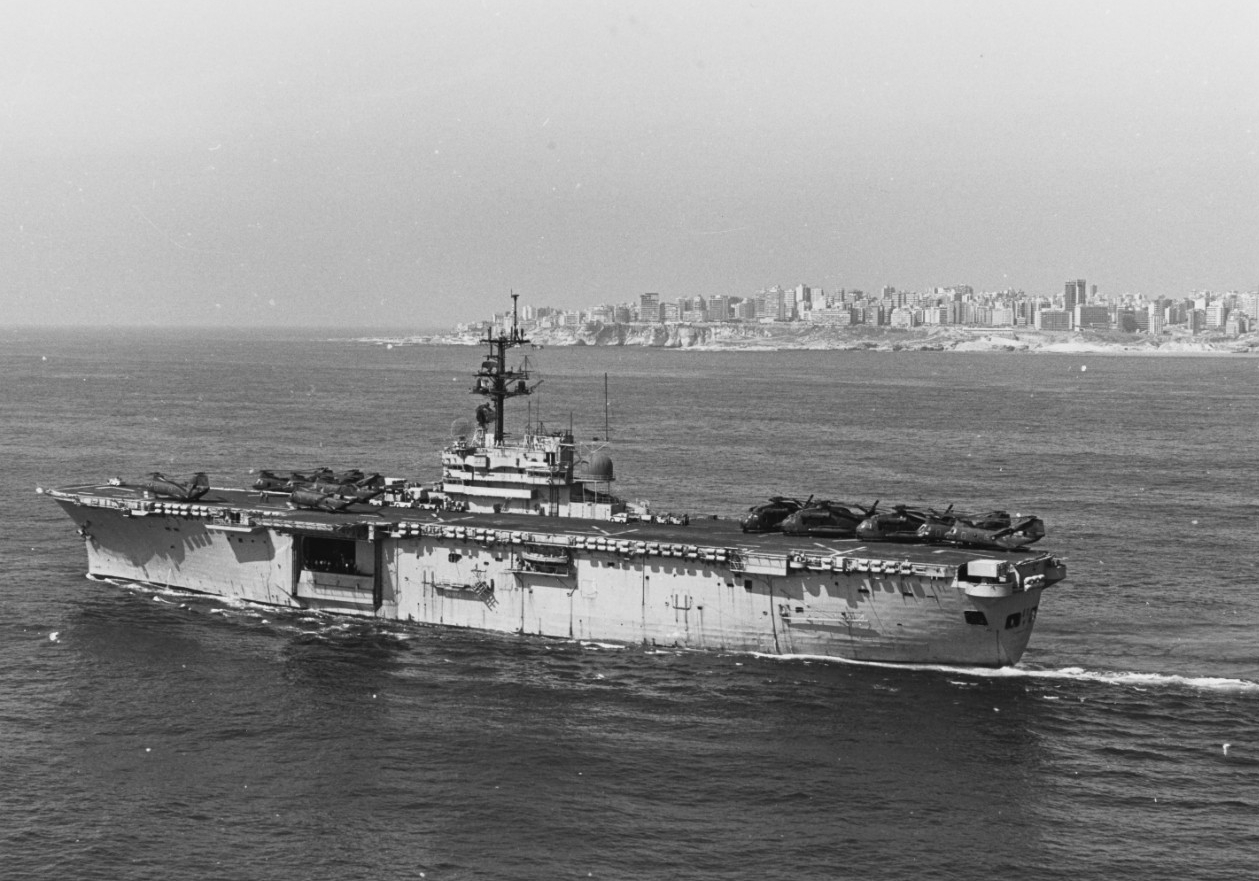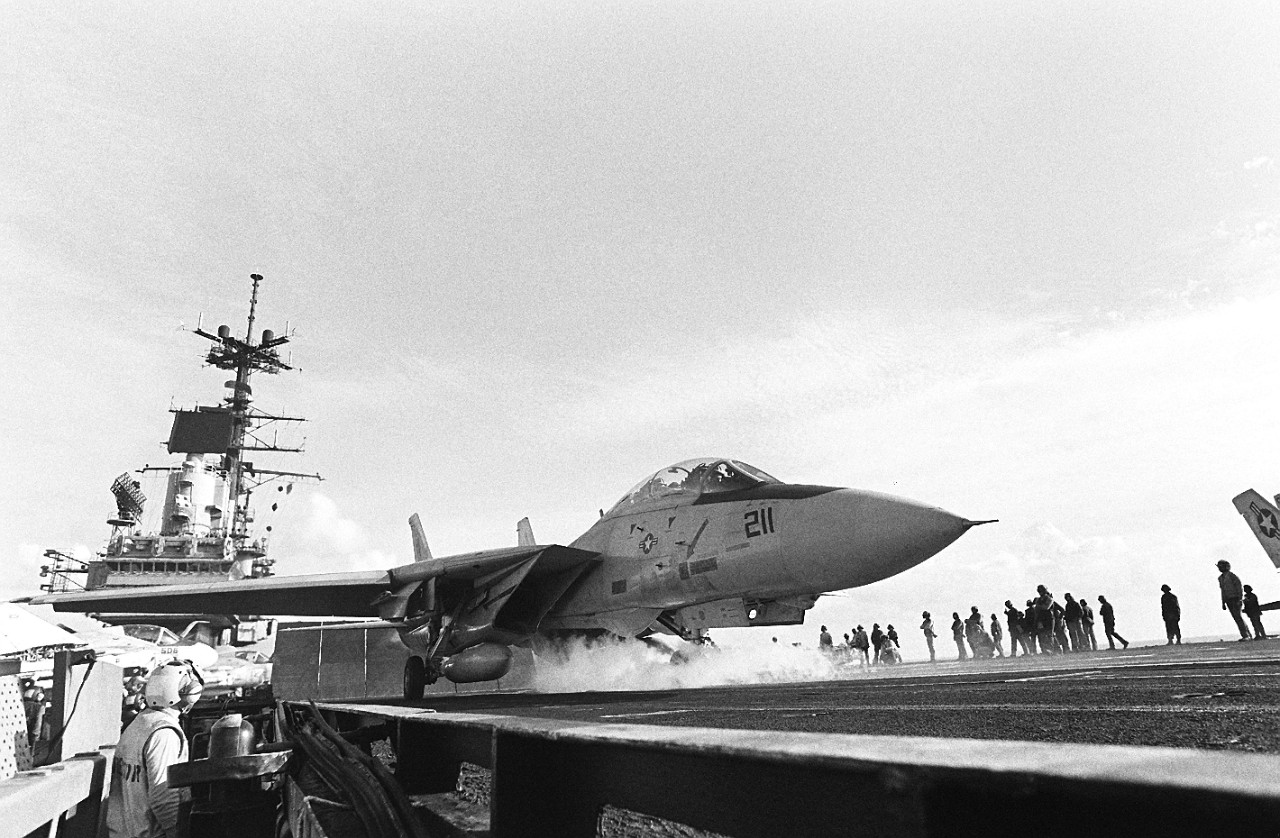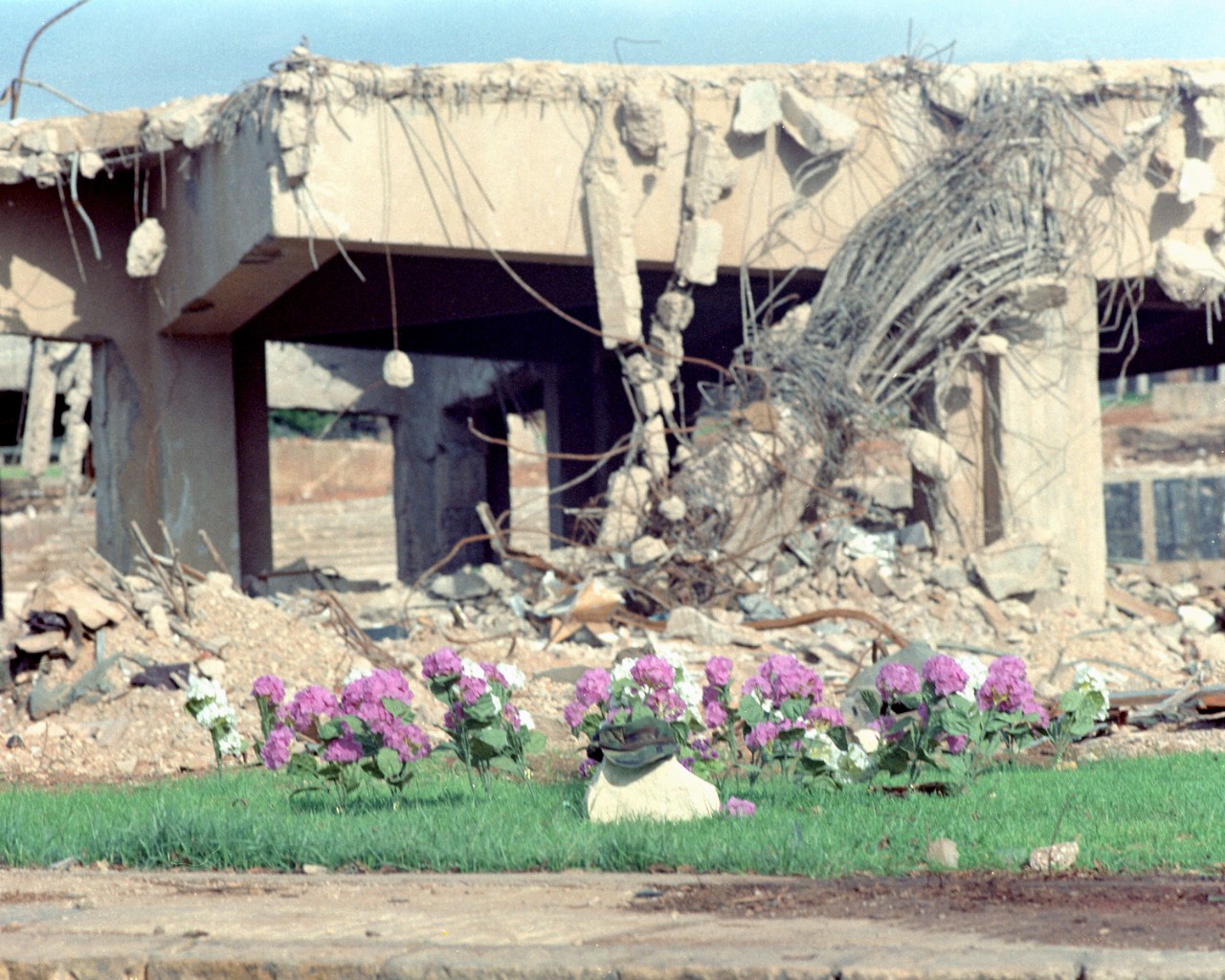H-Gram 080: Paved with Good Intentions—The U.S. Navy in the 1983 Lebanon Crisis
12 April 2024
This H-gram was originally drafted in November 2023 to commemorate the 40th anniversary of the 1983 Lebanon Crisis, but required some additional revision and editorial preparation. It primarily covers the terrorist bombings of the U.S. embassy (17 U.S. dead) and U.S. Marine Corps barracks in Beirut (241 U.S. dead); numerous U.S. Navy gunfire support missions (including by battleship New Jersey); F-14 combat reconnaissance missions; and an airstrike on Syrian targets in Lebanon by carrier aircraft. The latter resulted in two U.S. Navy aircraft shot down, with one pilot killed and a bombardier/navigator captured in what was generally regarded as a fiasco—but not for lack of courage on the part of the aviators.
The 1983 Lebanon Crisis—A War with No Name
“Never get involved in a five-sided argument that’s been going on for 2,000 years.”
—Secretary of the Navy John Lehman
On 4 December 1983, 28 A-6 and A-7 jets from USS John F. Kennedy (CV-67) and USS Independence (CV-62) struck three inconsequential Syrian targets in Lebanon. One A-7 and one A-6 were shot down by shoulder-fired surface-to-air missiles (SAMs); the pilot of the A-6 was killed and the bombardier/navigator taken prisoner by the Syrians. Most of the U.S. Navy jets launched with the incorrect ordnance or with partial loads, and the crews were inadequately briefed, due to a last minute switch to an earlier launch time dictated by “higher authority” (unidentified to this day) over the objection of the on-scene commander, Rear Admiral Jerry O. Tuttle (CTF-60). There was no time to execute a deception plan, so the Syrians had ample warning. The time of day (early morning) was the worst time to strike that part of Lebanon due to shadow and mist. All for targets dictated by “higher authority,” which Rear Admiral Tuttle assessed as not “worth a damn.” The raid was ostensibly in retaliation for Syrian missiles fired at an F-14 reconnaissance mission over Lebanon the previous day, despite the fact that more than 40 F-14 TARPS (Tactical Airborne Reconnaissance Pod System) missions (most from USS Dwight D. Eisenhower [CVN-69]) had previously been fired on with no U.S. response.
The U.S. Department of Defense spokesman described the 4 December raid as “very successful.” Few who were involved in this first U.S. Navy air strike since the Vietnam War era would say the same. Many compared it unfavorably to the Israeli strike in the Bekaa Valley of Lebanon in June 1982, in which 29 of 30 SAM batteries (most SA-6s) were destroyed and at least 82 Syrian fighters shot down, for no Israeli losses. (On the plus side, lessons from this raid directly led to the creation of the Naval Strike Warfare Center.)
The air raid followed on the heels of the 18 April 1983 suicide truck bombing of the U.S. embassy in Beirut, which killed 17 Americans (and 46 others) and resulted in the largest loss of life in a single day in CIA history (8), as the CIA station was decimated in the blast. This was to cripple U.S. human intelligence capability in the region.
The embassy bombing was followed on 23 October by a suicide truck bombing of the U.S. Marine Corps Battalion Landing Team barracks at Beirut International Airport, where the Marines were on a “peacekeeping” mission as part of a loosely coordinated Multi-National Force (MNF). The massive blast killed 241 Americans, including 220 Marines, 18 Navy, and 3 Army personnel. It was the largest loss of life in a single day for the Marines since the first day of the amphibious assault on Iwo Jima. It was the largest loss of life in a single day for the U.S. armed forces since the first day of the Tet Offensive in Vietnam in 1968.
Both attacks were conducted by the Islamic Jihad Organization, funded and trained by the Iranian Revolutionary Guard Corps at a facility in the Syrian-occupied area of the Bekaa Valley. There was no U.S. response to either attack, other than caring for the wounded and transporting the dead, and a lot of intense contingency strike planning by three U.S. aircraft carriers that ultimately amounted to nothing.
The U.S. intervention in Lebanon in 1982–84 has no catchy name like “Desert Storm” or “Enduring Freedom.” If anything, it is referred to as “USMNF” (U.S. Multi-National Force). Supposedly a peacekeeping mission, it was very much a combat mission from August 1983 to February 1984, when it ended in failure, having ultimately cost nearly 270 U.S. military lives.
This period included more than 15 major U.S. naval gunfire support (NGFS) missions, including more than 300 16-inch rounds from the battleship USS New Jersey (BB-62) and more than 1,500 5-inch rounds from at least eight other U.S. Navy warships. Many New Jersey rounds missed due to unreliable powder, although one killed the general in charge of Syrian forces in Lebanon. The shots by USS Bowen (FF-1079) on 8 September, in support of Marines being shelled, were the first fired in anger by the U.S. Navy since the Vietnam/Mayaguez era. The USS Ticonderoga (CG-47), in the first deployment by an AEGIS cruiser, fired her guns in anger for the first time.
The great majority of shells fired by Navy ships did in fact hit their targets. However, this convinced the various Muslim factions in Lebanon that the United States was no longer a “neutral peacekeeper,” but had taken the side of the predominately Christian Lebanese government in the developing civil war. Their perception was correct, even though leadership in Washington failed to see it.
This period also included the first F-14A TARPS combat missions. Commencing on 7 September, VF-143 off IKE flew 39 TARPS missions over Lebanon, with virtually every one fired on by missiles and anti-anti-aircraft artillery from Syrian-occupied areas of Lebanon.
The U.S. intervention in Lebanon in 1982 started with the best intentions, as the United States brokered a cease-fire agreement between Israel and the Palestine Liberation Organization (PLO). In response to cross-border attacks by the PLO, Israel had invaded Lebanon in June 1982, quickly trapping the PLO in the dense urban environment of Beirut. As Israeli jets pounded the city, Israel rapidly lost international support, and not wanting to incur the casualties of city combat, it agreed to the U.S. plan to create a multi-national force to guarantee the evacuation of the PLO from Beirut by sea to Tunisia, leaving behind Palestinian civilians in refugee camps in Beirut. France and Italy joined the United States in contributing forces to the MNF. In the U.S. case, this was a Marine amphibious unit (MAU) deployed from amphibious ships.
The evacuation of the PLO went well. However, as soon as the MNF pulled out, Christian militia personnel were allowed to pass through Israeli lines to root out any PLO stay-behinds. Instead, the militia massacred probably well over 1,000 Palestinians, mostly women and children in the Sabra and Shatila refugee camps. Shocked by the massacre, and embarrassed, since the MNF was supposed to provide security for the camps under the agreement, the MNF nations quickly put their forces back into Lebanon.
The wisdom of putting U.S. Marines back into Lebanon in the middle of an on-again, off-again multi-sided civil war that had raged since 1975, was hotly debated in Washington, DC. The Department of Defense, Department of State, and the National Security Council, were already mired in debilitating turf wars, so consensus was never truly achieved. The mission was unanimously opposed by the Joint Chiefs of Staff and the Secretary of Defense, yet went forward anyway. Nor was there consensus on what the mission actually was. In the absence of firm direction, the Marines on the ground in Lebanon suffered from “mission creep” and the “peacekeeping” mindset detracted from combat readiness. Rules of engagement remained confusing. The chain of command was confusing (and confused).
As the situation in Lebanon deteriorated rapidly in the summer of 1983, the U.S. inter-agency bureaucracy could not keep up as the Marines first got caught in the crossfire and then became targets. U.S. Navy ships initially fired in support of the Marines, but then were directed to fire in support of the Lebanese army, thus ending any pretense of neutrality, and ultimately dooming the mission as the Lebanese army finally collapsed into religious factionalism.
In the aftermath of the Marine barracks bombing, President Reagan directed the formation of a commission headed by recently retired Admiral Robert Long. His report was “scathing” in its assessment of the actions and inactions of the entire chain of command (applicable to the 4 December raid as well). It was so inconveniently scathing that it was effectively shelved, with few recommendations implemented, going down in history as a case of “lessons not learned.” Given current events, it may be worth dusting off.
(Note: In the email version of this H-gram sent to active duty and retired Navy flag officers, I received more than the usual "and I was there" feedback, most of it extremely interesting. Some of the feedback concerned the policy disputes between the White House/National Security Council/Department of State versus the Department of Defense/Joint Chiefs of Staff. In this note, I tried to stay focused on fleet operations and provide only enough detail about what was going on in Washington to provide historic context, and I may have oversimplified. There are some strong voices by respected flag officers with first-hand knowledge who believe that the SECDEF and JCS Chairman willfully chose not to carry out the direction of the President faithfully, which led to the failure of the U.S. effort in Lebanon. There are others of similar gravitas and bona fides who believe that the President's policy was unrealistic and unworkable, and believed it would lead to failure. To be blunt, it would take me a lot more research to sit in judgement between these opposing views. I will just note that the Marines, sailors, soldiers, and CIA personnel who died executing this policy did their duty faithfully.)
For a more detailed account of U.S. Naval operations during the 1983 Lebanon Crisis—and my personal account of the crisis from the perspective of a junior naval intelligence officer —please see the appended PDFs below:
H-080-1: Operation "No Name"—The U.S. Navy in Lebanon, 1982–84 (900 KB)
H-080-2: The Lebanon Crisis, 1983—A Personal Recollection (600 KB)
As always, you are welcome to disseminate H-grams widely. Previous H-grams may be found here.





